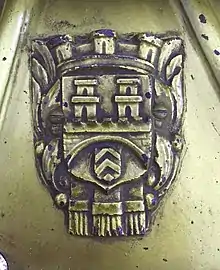
Th. Mann & Co. was a German piano factory, existing in Bielefeld, Prussian Province of Westphalia, from 1836 until 1942, as well as instrument shop for pianos and harmoniums with temporary branch offices in Gütersloh, Herford, Detmold, Rinteln and Paderborn.[1][2][3]
Christian Wilhelm Volkening
(occasionally J. Volkening, * around 1807 in Hille,[4] † October 26, 1858 in Bielefeld)[5]
Volkening was an apprentice with Andreas Streicher in Vienna.[6] Following his apprenticeship he went with two other assistants, Klems and Sassenhof, to northern Germany. While Klems continued his work in Düsseldorf and Sassenhof in Bremen, Volkening founded his piano workshop 1836 in Bielefeld.[7]
As a young instrument maker in Bielefeld, Volkening presented his grand pianos and uprights at the General German Trade Exhibition in Berlin in 1844,[8][9][10] where he exhibited an upright and a grand piano with Streicher's patent mechanics,[8] and at the first industrial exhibition of all peoples in London in 1851.[11] In Berlin, his instruments were noticed by the professional audience: Volkening „lieferte in einem sowohl durch Ton als Spielart sehr ansprechenden Flügel und einen Pianino um so Verdienstlicheres, als ihm in dem kleinen Städtchen wohl schwerlich vorzügliche Muster zu Gebote stehen.“[12] (Roughly: [Volkening] delivered with an upright piano and grand piano with a very appealing tone and style of playing something even more meritorious considering that he could hardly find excellent model exemplars in this small town.) The following year Volkening received the bronze medal at the "Gewerbeproducenten" exhibition in Berlin.[13]
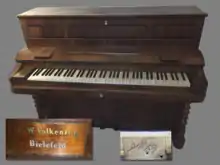
Around 1840 Volkening made a mahogany veneered grand piano on vase-like legs and with maple inlaid jewelry, which was played by Franz Liszt on his concert tour in 1841. A personal inscription of Liszt testifies to this concert on the instrument: "Bielefeld - concert on November 13 F. Liszt."[14] The instrument is now in the collection of the Museum of Musical Instruments of the University of Leipzig.[15]
After own statement of the later factory Th. Mann & Co Volkening made one of the first baby grand piano, which design idea was recognized by a Saxon princess at a concert in Bad Oeynhausen 1850/51 and afterwards brought to Dresden.[7][16]
C. W. Volkening founded his business allegedly in the so-called "Kühneschen Haus" at Kreuzstraße 565 in Bielefeld and employed 6 assistants.[5][17][18]
Theophil Mann sen.
(Occasionally also Theophilus Mann or Theodor Mann, * April 14, 1831, † June 21, 1913)

Theophil Mann was born the son of a master ropemaker in Hildesheim. Following his schooldays, he completed a carpentry apprenticeship before gaining an insight into piano construction in the workshop of the court instrument maker J. H. Weykopf in Hanover from 1848 onwards. After a short period, he returned to Hildesheim and worked with organ builder Heinrich Schaper. In 1849 C. W. Volkening called him to Bielefeld.[19] Under Volkening, Th. Mann studied the piano construction industry from the ground up. To deepen his knowledge, Mann made in 1853 visits in the workshops of Ernst Irmler junior in Leipzig, Eduard Voigt and Karl Rönisch in Dresden, Karl Schönberner in Bautzen, Alois Bieber in Munich and Carl Blädel in Stuttgart.[20]
After the death of Volkening, Theophil Mann took over the workshop and continued as "Pianoforte=Fabrik Th. Mann, Bielefeld" (pianoforte factory).[21] His goal was the production of high-quality pianos with a well-trained staff.[6] In the beginning of the company Theophil Mann sen. employed nine workers.[17] The production quality had an effect on the instrument sales, and its increase made it necessary to expand the workshop.[22]
In 1868 the new building at Oberntorwall 29 in Bielefeld was completed and the factory moved out of the building Kreuzstrasse 565.
Like Volkening before, Th. Mann sent exhibits to numerous industrial exhibitions in Germany and abroad. At the Industrial and Art Exhibition in London in 1862, Theophil Mann showed "a pianino with the device (...) of a 'movable hammer chair' instead of the Pédales céleste."[23][24]
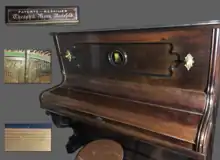
For the year 1871, it is noted in the catalog of the Vienna World Fair in 1873 that Th. Mann employed 20 workers and produced 120 instruments that year, the sale of which made a revenue 24,000 Thaler.[25][26]
In 1873, Th. Mann presented at the world exhibition in Vienna three pianos for which he received a medal for merit. A cross-stringed piano for 975 Reichsmark, a straight-stringed instrument for 822 Rmk and a diagonal-stringed piano for 675 Rmk were on display. The ingenuity of the instrument maker, the solid construction of the pianos and their "noble (soft) tone" were emphasized.
Shortly before the arrival of Hermann Steinhaus, the pianoforte factory Th. Mann employed 40 workers.[27]
Private life
On September 14, 1896, Th. Mann and his wife Sophie Mann, b. Oldermann (born July 7, 1839, † January 7, 1915) celebrated their silver wedding with relatives, friends and employees.[28]
Social Commitment
Theophil man sen. was on the board of the von Bodelschwinghsche Anstalten (today Stiftungen) and initiated, together with Friedrich von Bodelschwingh the society "Arbeiterheim", which had the goal to create cheap livingspace for factory workers in Bielefeld.
.jpg.webp) Th. Mann sen., Th. Mann jun. and Theodore H. Mann, around 1906
Th. Mann sen., Th. Mann jun. and Theodore H. Mann, around 1906 Theophil Mann sen., ca. 1900
Theophil Mann sen., ca. 1900 Theophil Mann jun., ca. 1930
Theophil Mann jun., ca. 1930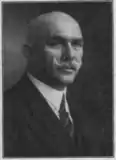 Max Porth, around 1935
Max Porth, around 1935
Hermann Steinhaus & Th. Mann & Co.

(Occasionally Wilhelm Steinhaus, * July 17, 1850, † February 9, 1933)[29][30][31]
Hermann Steinhaus was offspring of a respected family from Barmen. Steinhaus came to Bielefeld at the age of 22 and joined the piano factory Th. Mann as partner. From 1972 the factory was trading under the name Th. Mann & Co or Th. Mann & Cie. In some publications, the name was shortened to Mann & Co. or Mann & Cie.

In 1875, Th. Mann & Co. began erecting new buildings at the nearby Friedenstraße and the fabrication was converted to steam operation, which resulted in an increase of the body of workers.[32][33]
In the early morning hours of October 19, 1879, a fire broke out in the engine room of the factory, which was located towards the Grabenstrasse. With great effort of the local fire brigades it could be contained and extinguished without spilling over to adjacent buildings.[19][34] According to the company's own information, the damage was minor.[35]
H. Steinhaus and Th. Mann were able to increase the quality and quantity of production, which was reflected in numerous acquired medals. The company scored a bronze medal for pianos in Düsseldorf in 1880.[36] At the Amsterdam Colonial Exhibition in 1883, the company won a gold medal for pianinos.[37] Likewise at the Antwerp International Exhibition in 1885, Th. Mann & Co. scored "the golden medal as a prize of first class for their pianinos."[38] Th. Mann & Co also achieved a golden medal for pianos at the World's Fair in Brussels in 1888.[38] Later, at the Düsseldorf exhibition in 1902 they were able to achieve a silver medal.[39]
In 1883 Th. Mann & Co. already employed 70 workers.[17]
Social Commitment
Hermann Steinhaus worked for years as a presbyter of the Neustädter Marienkirchengemeinde in Bielefeld.[40]
Theophil Mann jr.
(* 8 February 1873, † March 18, 1935)

Due to age, Th. Mann sen. retired in 1905, and his son, who studied at Steinway & Sons in New York, C. Bechstein in London and in Paris, took over the technical management of the company.[41]
Shortly before the outbreak of the First World War, the factory employed 100 workers, who made a piano every five hours, whereby a wagon load was exported weekly by train. At this time Th. Mann pianos were shipped to England, Belgium, Italy and other European countries, as well as overseas.[17]
In 1926, the company celebrated its 90th anniversary with an elaborate jubilee publication.[22]
In the aftermath of the First World War and the loss of access to the world market, the factory operations were in 1930 finally reunited to the site Oberntorwall 29.[17]
As a result of the death of Hermann Steinhaus in February 1933, Theophil Mann jun. became sole owner of the piano factory. Despite the dissolution of the company, the name Th. Mann & Co. continued to exist as a trademark.[42]
Helene Mann
(born Nacken, * October 7, 1878, † November 4, 1939)[43] After the death of Theophil Mann jr., his wife continued the business.[44]
The 100th anniversary was celebrated in 1936 with an extensive festival program.[45]
Max Porth
(* 1886, † 1943)
In 1942 the Berlin merchant and piano dealer Max Porth bought the factory. With that, the procuration of Rudolf Rosenberger ended. By that time, a business was in progress.[46]
End of production
Nothing is known about the actual stop of production. The highest opus number recorded in the literature is stated to be 20,000 for the year 1938.[47] In most cases 1938 or 1939 are mentioned for the year the production discontinued.[1][5]
The factory buildings were allegedly victims of the bombing in the Second World War, in which large parts of Bielefeld city center were destroyed. Aerial views of the 1950s show a vacant lot on the site of the parent company. Furthermore, the object Oberntorwall 29 is listed as totally destroyed for the post-war period.[48]
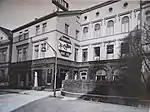 Main building at Oberntorwall 29
Main building at Oberntorwall 29 Decorated showroom at Oberntorwall 29, Oct. 1936
Decorated showroom at Oberntorwall 29, Oct. 1936 So called "Musiksaal" in main building, Oberntorwall 29
So called "Musiksaal" in main building, Oberntorwall 29 Main building of Th. Mann & Co., view from Oberwallstraße (also called Grabenstraße or Hindenburgstraße)
Main building of Th. Mann & Co., view from Oberwallstraße (also called Grabenstraße or Hindenburgstraße)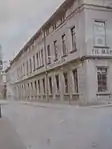 Factory building at Friedenstraße
Factory building at Friedenstraße
Patents, utility models and special designs
- 1874: "Peculiar arrangement of pianos and grand pianos."[49]
- 1874, April 10: "Improvement in the construction of Grand Pianos and Pianinos to improve the tuning duration."[50]
- Before Nov. 1884: Mann & Co's Capo d'Astro.[51]
- 1885, March 20, DRP 35688: "Invention of the exposure of the soundboard, whereby the disk lies far away from the bridge in the treble, but the strings are held at the correct distance from the bridge by a narrow string. As a result, an area of the soundboard is freed from the iron plate, which is of great importance for the spread of sound. (...)"[52]
- 1885, July 26, DRP 35690: "Attachment of the strings for pianos and alike"[53]
- Before Sept. 1886: "Pressure bridge (with metal frame and tuning plate cast in one piece)."[54]
- 1892, February 3, DRP 65871: "Soundboard with recessed bridge. With this they want to achieve the same richness of sound for all notes that it forms a natural node line for all tones. (...)"[55][56]
- 1892, April 7, DRP 66166: Device for collecting and guiding the sound waves in pianinos.[57] System Th. Mann & Co., "Tonwellen-Sammler".[58]
- 1902, March 20, DRP 136860: keyboard for grand pianos and pianinos.[59]
- 1904, March 19, utility model 222497: Wrestplank for grand pianos.[60]
Instruments in public collections
- The foremost piano played by Franz Liszt and made by Volkening in 1840 is located in the Museum of Musical Instruments of the University of Leipzig.[61]
- In the musical instrument collection of the Cincinnati Art Museum is a "Grand Piano" by C.W. Volkening.[62]
- In the inventory of the Museum of Musical Instruments Brussels is a black pianino by Th. Mann & Co., allegedly created around 1900.[63]
Instrument makers in Bielefeld
Other instrument makers in Bielefeld were August Festing, whose workshop existed from 1901 to 1933, and Louis Ext, whose company emerged from the operation of the instrument maker and pianostudio Heinrich Ext (Kreuzstraße 645b[64]) and filed for bankruptcy in April 1887.[65] In his doctoral thesis, Jürgen Oberschelp also mentioned W. Pohlmann and H. Steinhaus. Latter is probably identical to the partner in Th. Mann & Co., Hermann Steinhaus.[16]
External links
References
- 1 2 Martha Novak (1999), Makers of the Piano Bd. 2; 1820-1860 (in German), Oxford, p. 245
{{citation}}: CS1 maint: location missing publisher (link) - ↑ Festausschuß, ed. (1909), Festschrift zur Neunzehnhundertjahrfeier der Schlacht im Teutoburger Walde (in German), Detmold: Verlag der Lippischen Landeszeitung, p. 92
- ↑ Paul de Wit, ed. (1912), Welt-Adreßbuch der gesamten Musikinstrumenten-Industrie (in German), vol. 1, Leipzig
{{citation}}: CS1 maint: location missing publisher (link) - ↑ "Klang durch ein Jahrhundert; 100 Jahre Mann-Flügel und -Klaviere", Westfälische Zeitung (in German), Bielefeld, vol. 126, no. 230, p. 5, 1936-10-01
- 1 2 3 Herbert Heyde (2005), Musikinstrumentenbau in Preußen (in German), Tutzing, pp. 418f
{{citation}}: CS1 maint: location missing publisher (link) - 1 2 Magistrat der Stadt Bielefeld, ed. (1926), Das Buch der Stadt (in German), Bielefeld, p. 623
{{citation}}: CS1 maint: location missing publisher (link) - 1 2 Th. Mann & Cie (1889), "Betrachtungen über den Klavierbau im 19. Jahrhundert mit ausschliesslicher Beziehung auf Deutschland", Zeitschrift für Instrumentenbau 1888/1889 (in German), Leipzig, vol. 9, no. 1, pp. 4ff
- 1 2 Carl Galliard, ed. (1844), "Die musikalischen Instrumente auf der Berliner Industrie-Ausstellung. (Fortsetzung.)", Berliner Musikalische Zeitung (in German), Berlin, no. 39, p. 2,
Der Flügel (...) und das Pianino sind beides ganz erfreuliche Leistungen. Eine leicht ansprechende Claviatur, schöner gesangvoller Ton, eine durchweg korrekte Arbeit und hübsche äussere Ausstattung, machen dieselben bei dem mässigen Preise gewiss aller Anmerkung werth.
- ↑ Carl Gaillard, ed. (1844), "Die musikalischen Instrumente auf der Berliner Industrie-Ausstellung (Schluss)", Berliner musikalische Zeitung (in German), Berlin, no. 41, p. 1
- ↑ Amtlicher Bericht über die Allgemeine Deutsche Gewerbe-Ausstellung zu Berlin im Jahre 1844, Dritter Teil (in German), Berlin, 1845, p. 207,
„C. W. Volkening, in Bielefeld, lieferte einen durch Ton und Spielart ansprechenden Flügel zum Preise von 350 Rthl."
- ↑ Beilage zur Illustrierten Zeitung (in German), vol. 16, Leipzig, 1851, p. 66,
The official list of exhibitors doesn't name Volkening: Amtliches Verzeichnis der aus dem deutschen Zollverein und Norddeutschland zur Industrie-Ausstellung aller Völker in London eingesandten Gegenstände, Berlin 1851.
{{citation}}: CS1 maint: location missing publisher (link) - ↑ Allgemeine Wiener Musik-Zeitung (in German), vol. 4, Wien, 1844, pp. 546f
- ↑ August Schmidt, ed. (1844), Wiener Allgemeine Musik-Zeitung (in German), vol. 5, Vienna, p.108
- ↑ Georg Kinsky (1910), Katalog des Musikhistorischen Museums von Wilhelm Heyer in Köln, Erster Band (in German), Köln, p. 195
{{citation}}: CS1 maint: location missing publisher (link) - ↑ "Img. & further reading". Retrieved 2019-02-27.
- 1 2 Jürgen Oberschelp (1972), Das öffentliche Musikleben der Stadt Bielefeld im 19. Jahrhundert (in German), Regensburg, p. 120
{{citation}}: CS1 maint: location missing publisher (link) - 1 2 3 4 5 Schrader (1936), "100 Jahre der Bielefelder Firma Th. Mann & Co.", Ravensberger Blätter (in German), vol. 36, no. 9, pp. 71-72
- ↑ "Die Firma Th. Mann & Co., Pianofortefabrik, Bielefeld", Zeitschrift für Instrumentenbau (in German), Leipzig, vol. 57, p. 10, 1936
- 1 2 "Die Firma Th. Mann & Co., Pianofortefabrik, Bielefeld", Zeitschrift für Instrumentenbau (in German), Leipzig, vol. 57, p. 10, 1936
- ↑ Paul Neumann (1933), "Th. Mann sen. +", Zeitschrift für Instrumentenbau 1912/1913 (in German), Leipzig, vol. 33, pp. 1124ff
- ↑ Signale für die musikalische Welt (in German), vol. 19, 1861, p. 290,
Written as contact in an advertisement: „Ein Zusammensetzer, dem viel Gelegenheit zu weiterer Ausbildung geboten, wird auf recht bald gesucht von der Pianoforte=Fabrik Th. Mann in Bielefeld."
- 1 2 Th. Mann & Co. (1926), Festschrift zum 90-jährigen Bestehen inkl. Produktkatalog und Preisliste (in German), Bielefeld, p. 2
{{citation}}: CS1 maint: location missing publisher (link) - ↑ Amtlicher Bericht über die Industrie- und Kunst-Ausstellung in London im Jahre 1862 erstattet nach Beschluss der Kommissarien der Deutschen Zollvereins-Regierungen, 2. Heft (in German), Berlin, 1863, p. 81
{{citation}}: CS1 maint: location missing publisher (link) - ↑ Leipziger Zeitung (in German), Leipzig, 1862, p. 1
{{citation}}: CS1 maint: location missing publisher (link) - ↑ Oscar Paul (1874), Musikalische Instrumente; Autorisierter Abdruck aus dem 'Amtlichen Bericht über die Wiener Weltausstellung im Jahre 1873'. Bd. 2 Heft 5. (in German), Braunschweig, p. 55
{{citation}}: CS1 maint: location missing publisher (link) - ↑ Allgemeine musikalische Zeitung (in German), vol. 8, 1873, col. 651
- ↑ Christoph Sandler (1873), Handbuch der Leistungsfähigkeit der gesammten Industrie Deutschlands, Oesterreichs Elsass-Lothringens und der Schweiz, Band 1, VI. u. V. Serie (in German), Leipzig, p. 41
{{citation}}: CS1 maint: location missing publisher (link) - ↑ Zeitschrift für Instrumentenbau (in German), vol. 16, Leipzig, 1896, p. 983
{{citation}}: CS1 maint: location missing publisher (link) - ↑ Zeitschrift für Instrumentenbau 1929/30 (in German), vol. 50, Leipzig, 1930, p. 718
{{citation}}: CS1 maint: location missing publisher (link) - ↑ Zeitschrift für Instrumentenbau 1932/33 (in German), vol. 53, Leipzig, 1933, p. 166
{{citation}}: CS1 maint: location missing publisher (link) - ↑ "Grabstein Hermann Steinhaus" (in German). Retrieved 2019-03-08.
- ↑ Bericht der Handelskammer zu Bielefeld für die Jahre 1876 und 1877 (in German), Bielefeld, 1878, p. 53
{{citation}}: CS1 maint: location missing publisher (link) - ↑ Bericht der Handelskammer zu Bielefeld für das Jahr 1875 (in German), Bielefeld, 1876, p. 76
{{citation}}: CS1 maint: location missing publisher (link) - ↑ "4. Januar 1860: Die Bielefelder Turngemeinde (BTG) beschließt die Gründung einer Turnerfeuerwehr". Retrieved 2019-02-18.
- ↑ Bericht der Handelskammer zu Bielefeld für das Jahr 1879 (in German), Bielefeld, 1880, p. 91
{{citation}}: CS1 maint: location missing publisher (link) - ↑ Zeitschrift für Instrumentenbau (in German), vol. 1, Leipzig, 1880, p. 35
{{citation}}: CS1 maint: location missing publisher (link) - ↑ Musikalisches Wochenblatt (in German), vol. 14, Leipzig, 1883, p. 432
{{citation}}: CS1 maint: location missing publisher (link) - 1 2 Neue Zeitschrift für Musik (in German), vol. 81, Leipzig, 1885, p. 329
{{citation}}: CS1 maint: location missing publisher (link) - ↑ Gottfried Stoffers, ed. (1903), Die Industrie- und Gewerbe-Ausstellung für Rheinland, Westfalen und benachbarte Bezirke verbunden mit einer deutsch-nationalen Kunst-Ausstellung in Düsseldorf 1902 (in German), Düsseldorf, p. 270
{{citation}}: CS1 maint: location missing publisher (link) - ↑ "Nachruf", Westfälische Neueste Nachrichten (in German), Bielefeld, 1933-02-10
- ↑ Zeitschrift für Instrumentenbau 1934/1935 (in German), vol. 55, Leipzig, 1935, p. 220
{{citation}}: CS1 maint: location missing publisher (link) - ↑ Paul de Wit, ed. (1933), Zeitschrift für Instrumentenbau (in German), vol. 53, Leipzig: Paul de Wit, p. 230
- ↑ Westfälische Neueste Nachrichten (in German), vol. 39, Bielefeld, 1939-11-06, p. 4
{{citation}}: CS1 maint: location missing publisher (link) - ↑ Zeitschrift für Instrumentenbau (in German), vol. 60, Leipzig, 1939, p. 36
{{citation}}: CS1 maint: location missing publisher (link) - ↑ Zeitschrift für Instrumentenbau 1935/1936 (in German), vol. 57, Leipzig, 1936, p. 10
{{citation}}: CS1 maint: location missing publisher (link) - ↑ Zeitschrift für Instrumentenbau (in German), vol. 62, Leipzig, 1942, p. 81
{{citation}}: CS1 maint: location missing publisher (link) - ↑ Jan Großbach (2009), Atlas der Pianonummern (in German) (11 ed.), Frankfurt a. M.
{{citation}}: CS1 maint: location missing publisher (link) - ↑ Stegmann. "Wiederaufbau der Bielefelder Alt- und Neustadt" (PDF) (in German). Retrieved 2019-02-27.
Further reading: Stadtplanungsamt 1952 Broschüre „Ist nichts geschehen?" and the map of Bielefeld city with highlighted buildings that were damaged or destroyed.
- ↑ "Einführungspatent des Theodor Mann in Bielefeld auf eigentümliche Anordnungen an Pianos und Flügeln" (in German). Retrieved 2019-03-01.
- ↑ Deutsche Industrie-Zeitung (in German), Chemnitz, 1874, p. 190
{{citation}}: CS1 maint: location missing publisher (link) - ↑ Musical Opinion and Trade Review (in German), vol. 8, London, 1884, p. 95
{{citation}}: CS1 maint: location missing publisher (link) - ↑ Zeitschrift für Instrumentenbau (in German), vol. 6, Leipzig, 1886, p. 271
{{citation}}: CS1 maint: location missing publisher (link) - ↑ Zeitschrift für Instrumentenbau 1885/1886 (in German), vol. 6, Leipzig, 1886, p. 334
{{citation}}: CS1 maint: location missing publisher (link) - ↑ Musical Opinion and Trade Review (in German), vol. 9, London, 1886, p. 586
{{citation}}: CS1 maint: location missing publisher (link) - ↑ Friedrich Weber-Robine (1913), Die Resonanz des Klaviers; Beiträge zur Entwicklungsgeschichte der Tasteninstrumente. (in German), Dresden, pp. 82f
{{citation}}: CS1 maint: location missing publisher (link) - ↑ Zeitschrift für Instrumentenbau (in German), vol. 13, Leipzig, 1892, p. 101
{{citation}}: CS1 maint: location missing publisher (link) - ↑ Zeitschrift für Instrumentenbau (in German), vol. 13, Leipzig, 1892, p. 151
{{citation}}: CS1 maint: location missing publisher (link) - ↑ Friedrich Weber-Robine (1913), Die Resonanz des Klaviers; Beiträge zur Entwicklungsgeschichte der Tasteninstrumente (in German), Dresden, pp. 53f
{{citation}}: CS1 maint: location missing publisher (link) - ↑ Zeitschrift für Instrumentenbau 1902/1903 (in German), vol. 23, Leipzig, 1903, p. 399
{{citation}}: CS1 maint: location missing publisher (link) - ↑ Zeitschrift für Instrumentenbau 1903/1904 (in German), vol. 24, Leipzig, 1904, p. 671
{{citation}}: CS1 maint: location missing publisher (link) - ↑ Museum für Musikinstrumente der Universität Leipzig. "Grand Piano C.W. Volkening" (in German).
- ↑ Cincinnati Art Museum, ed. (1949), "Musical Instruments", Collection of the Cincinnati Art Museum (in German), Ohio, pp. o. S.
- ↑ "Collection Musical Instruments, Inventory number 3837" (in Dutch). Retrieved 2019-03-22.
- ↑ Stadt Bielefeld (1865). "Adress book Bielefeld 1865" (PDF) (in German). Retrieved 2019-03-14.
- ↑ Zeitschrift für Instrumentenbau 1886/1887 (in German), vol. 7, 1887, p. 271